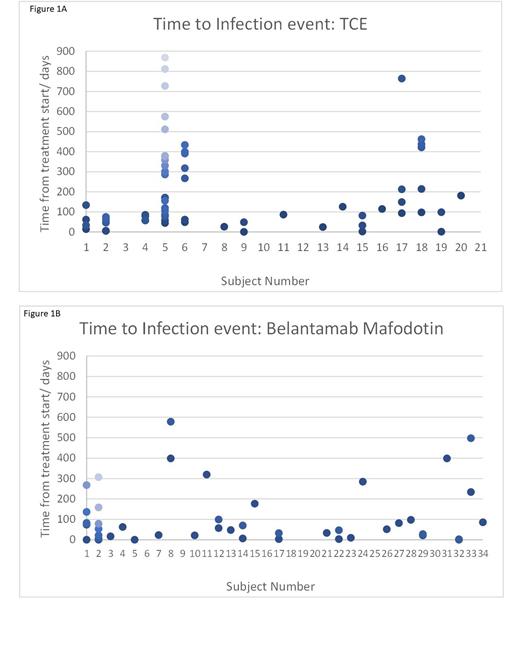Introduction: BCMA targeted therapies have demonstrated single agent efficacy for patients with triple class exposed or refractory multiple myeloma (RRMM). Teclistamab and Belantamab Mafodotin (Belamaf) are currently approved for RRMM in Europe with several Bispecific T Cell Engagers (TCE) under investigation. However, whilst TCEs have higher response rates and progression free survival to Belamaf, adverse events, particularly infections may influence treatment choice particularly for frailer patients. Intravenous Immunoglobulin (IVIg) is recommended to prevent infections once IgG levels fall <4g/L or even as prophylaxis with anti-BCMA TCEs.
Methods: This was a retrospective review of MM patients treated with anti-BCMA monotherapies at University College London Hospitals between 28/07/2015 and 15/06/2023. IVIg was given according to UK guidelines: IgG of <3g/L and recurrent infections/ one severe infection, despite 6 months of prophylactic antibiotics. IgG levels between 3-4g/L also required failure of a vaccine challenge. IVIg for asymptomatic patients was not permitted. Statistics was performed using GraphPad Prism.
Results: 55 patients were treated with anti-BCMA monotherapies: 21 with TCE and 34 with Belamaf. The median age was 61 years (range 45-79), 43% female, 80% white and 5.6% Black. The median time from diagnosis to treatment was 5.8 years with a median of 5 prior lines (range 2-15). 51.9% of patients had high risk cytogenetics.
Patients were a median of 59 years for TCE (range 47-73) vs 64 years (range 45-79) with Belamaf. Both groups had a median of 5 prior lines and a median Charlson co-morbidity index of 2, but 40% of TCE were classified frail by modified IMWG score vs 61.8% with Belamaf. CD38 exposure was 100% for TCE patients and 76% Belamaf. Severe hypogammaglobulinemia (<4g/L) at baseline prior to anti-BCMA treatment was present in 75% of TCE and 53% of Belamaf patients. Further significant reductions in median IgG levels occurred during treatment (TCE: 3.04g/L to 1.06g/L, p=0.01; Belamaf: 3.9g/L to 1.9g/L p=0.002). Nadir IgG levels were significantly lower with TCE than Belamaf (p=0.047). All patients received aciclovir prophylaxis, PJP prophylaxis (co-trimoxazole/ azithromycin) was given in 100% with TCE and 82% with Belamaf, with anti-fungal prophylaxis in 1 TCE patient. IVIg was used prior to anti-BCMA treatment in 3 patients (2 TCE, 1 Belamaf). Whilst on anti-BCMA treatment, IVIg was used in 38% for TCE and 5.9% for Belamaf.
The risk for all grade infection per patient was 3.7 times higher for TCE vs Belamaf (increased risk TCE vs Belamaf: G1-2: 3.3, G3: 2.1, G4: 2.1). There was a total of 104 infection episodes, 57% with TCE, 43% with Belamaf (see Figure). The median time to first infection was 45 days for TCE and 34 days for Belamaf. Most infections were low grade with 20 patients having ≥1 infection (10/21 (48%) TCE, 10/34 (29%) Belamaf). At Grade 1-2, there were 1.8 infections per patient for TCE vs 0.7 for Belamaf. For G3-5, 1.0 infections per patient vs 0.6 for Belamaf. There was 1 grade 5 infection with TCE, 0 for Belamaf. Respiratory infections predominated (TCE: 80% vs Belamaf: 73%) followed by urinary (TCE: 5% vs Belamaf 16%), blood (TCE 10% vs Belamaf 5.4%) and GI (TCE 3% vs Belamaf 5%). 96/ 104 infections were identified, most were viral (TCE 71% vs Belamaf 62%) with few fungal infections (6% vs 4%). More bacterial infections occurred with Belamaf possibly due to lower antibacterial prophylaxis and IVIg use (TCE: 23% vs Belamaf: 35%). Since commencing IVIg, 5 of 8 (63%) TCE patients had at least 1 infection, mainly viral. A median of 1 further infection (range 0-14) occurred over a median of 3.2m (range 0.6-28.3m) of monthly IVIg infusions.
Routine blood viral PCR monitoring for CMV, EBV & Adenovirus was performed in 30% of patients. 13 (65%) of TCE patients had 197 blood viral PCR tests performed of which 3 patients (23%) tested positive (2x adenovirus and 1 CMV). Of these 2 (both adenovirus) had symptoms requiring intervention. Of the 8.8% of Belamaf patients tested, 0 were positive.
Conclusions: Patients treated with Belamaf were frailer than those receiving TCE. Hypogammaglobulinemia was more profound with TCE and the per patient risk of infections was higher. IVIg use was substantially higher for TCE than Belamaf. Blood viral PCR monitoring for TCE patients only detected symptomatic reactivations in 2 out of 13 patients suggesting this was an infrequent event.
Disclosures
Popat:GSK: Consultancy, Honoraria, Research Funding; Janssen: Honoraria; BMS: Honoraria; AbbVie: Honoraria; Roche: Honoraria; University College London Hospitals NHS Foundation Trus: Current Employment. Wechalekar:Takeda: Other: Travel support; Janssen: Honoraria; Attralus: Honoraria; Alexion: Honoraria; GSK: Honoraria; Alexion, Attralus, Janssen, Prothena.: Consultancy.


